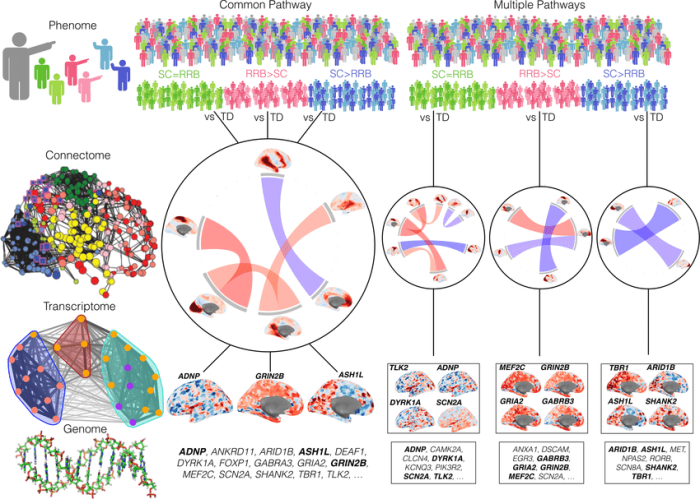What makes single common pathway explanations of autism attractive – Single common pathway explanations of autism have captivated the interest of researchers and clinicians alike, offering a tantalizing promise of simplifying the diagnosis and treatment of this complex neurodevelopmental disorder. However, the quest for a single, unifying explanation for autism faces significant challenges, as the evidence suggests that autism is a heterogeneous disorder with multiple contributing factors.
Despite these challenges, single common pathway explanations remain attractive due to their potential to provide a comprehensive understanding of autism’s causes and mechanisms. This article explores the factors that make single common pathway explanations appealing, discusses their potential benefits, and examines the challenges involved in finding a single, common pathway for autism.
1. Single Common Pathway Explanations
Single common pathway explanations of autism propose that a single underlying mechanism or pathway is responsible for the core symptoms of autism spectrum disorder (ASD). This pathway could involve a specific genetic mutation, a neurochemical imbalance, or a disruption in brain development.
Examples of proposed common pathways include:
- Defects in the mTOR pathway, which regulates cell growth and protein synthesis
- Mutations in genes involved in synaptic function, such as SHANK3 and NRXN1
- Imbalances in neurotransmitters, such as serotonin and dopamine
Advantages of single common pathway explanations include:
- Simplicity: They provide a straightforward explanation for the complex symptoms of ASD.
- Predictability: If a single pathway is identified, it could lead to more accurate diagnosis and targeted treatments.
Disadvantages of single common pathway explanations include:
- Oversimplification: ASD is a highly heterogeneous disorder, and it is unlikely that a single pathway can fully account for all cases.
- Lack of evidence: Despite extensive research, no single common pathway has been conclusively identified for ASD.
2. Attractiveness of Single Common Pathway Explanations

Single common pathway explanations are attractive to researchers and clinicians for several reasons:
- Potential for early diagnosis: If a single common pathway is identified, it could lead to the development of biomarkers that can be used to diagnose ASD early on.
- Development of targeted treatments: By understanding the underlying mechanism of ASD, researchers can develop targeted therapies that specifically address the core symptoms.
- Increased understanding of the disorder: Identifying a single common pathway would provide valuable insights into the causes and mechanisms of ASD, which could lead to a better understanding of the disorder overall.
3. Challenges to Single Common Pathway Explanations

Finding a single common pathway for ASD has proven to be challenging due to several factors:
- Heterogeneity: ASD is a highly heterogeneous disorder, with a wide range of symptoms and presentations. This suggests that multiple factors may contribute to the disorder.
- Genetic complexity: Genetic studies have identified hundreds of genes associated with ASD, making it difficult to pinpoint a single common pathway.
- Environmental influences: Environmental factors, such as prenatal infections and exposure to toxins, have also been linked to ASD, further complicating the search for a single common pathway.
4. Future Directions: What Makes Single Common Pathway Explanations Of Autism Attractive

Despite the challenges, research on single common pathway explanations of autism continues to be an active area of investigation. Future directions include:
- New technologies: Advances in genetic sequencing and neuroimaging technologies may help to identify new common pathways for ASD.
- Integrative approaches: Researchers are increasingly using integrative approaches that combine genetic, neuroimaging, and behavioral data to identify potential common pathways.
- Longitudinal studies: Long-term studies that follow individuals with ASD over time may provide insights into the developmental trajectories of the disorder and help to identify common pathways.
A better understanding of the causes of ASD could lead to improved treatments and ultimately to better outcomes for individuals with the disorder.
FAQ Compilation
What are the advantages of single common pathway explanations of autism?
Single common pathway explanations of autism offer several advantages, including the potential to simplify diagnosis and treatment, provide a comprehensive understanding of the disorder’s causes and mechanisms, and facilitate the development of targeted therapies.
What are the challenges to finding a single common pathway for autism?
The challenges to finding a single common pathway for autism include the heterogeneity of the disorder, the complex interplay of genetic and environmental factors, and the lack of a clear understanding of the underlying neurobiology of autism.
What are the future directions of research on single common pathway explanations of autism?
Future research directions on single common pathway explanations of autism will likely focus on identifying the specific genetic and environmental factors that interact to produce the diverse symptoms of autism, as well as developing new technologies and approaches to study the disorder.